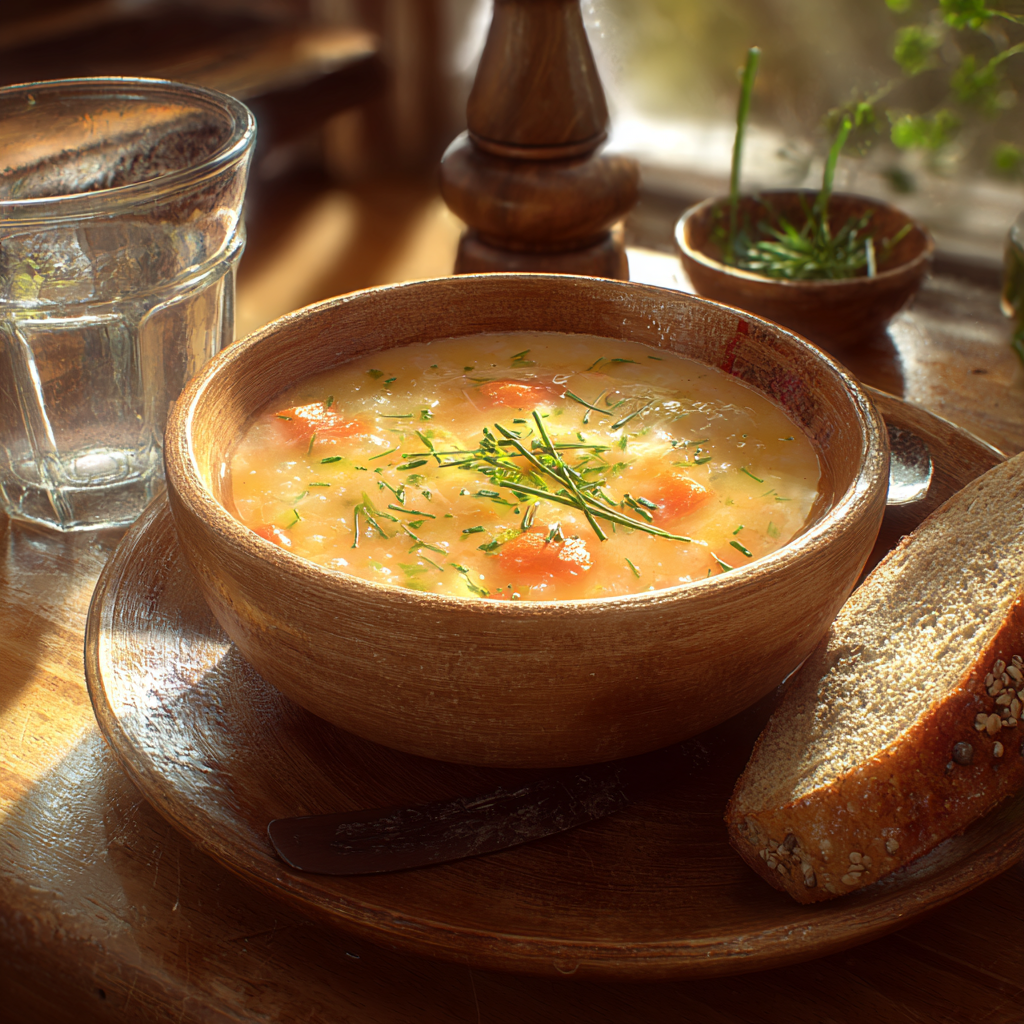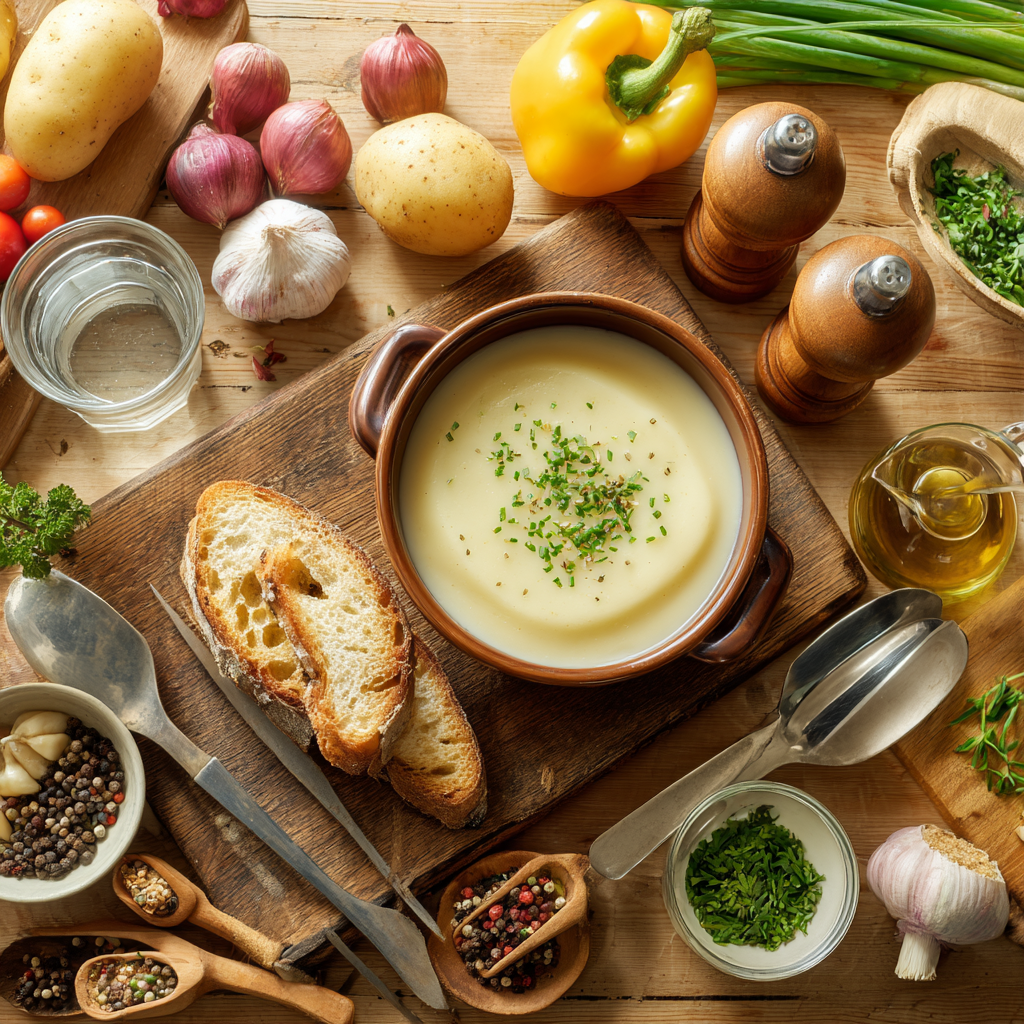
Introduction
There’s something magical about a bowl of hot, creamy soup on a chilly day. For me, it’s like a warm hug in a bowl. If you’ve ever tried Bob Evans Potato Soup, you know exactly what I mean. Its rich flavor and velvety texture make it a standout comfort food. But here’s the thing: not everyone can run to Bob Evans every time a craving hits. That’s why I’m sharing my take on the Bob Evans potato soup recipe. Whether you’re a fan of their menu or just love hearty soups, this recipe will bring that restaurant magic to your kitchen.
Before we dive into the details, let’s address a common question: Is Bob Evans potato soup vegetarian? Short answer: No, it isn’t. But don’t worry—I’ll show you how to tweak the recipe for plant-based diets. This way, everyone can enjoy a version of this comforting classic.
What Makes Bob Evans Potato Soup So Special?
Bob Evans Potato Soup is more than just a creamy bowl of goodness. It has a signature taste that balances earthy potatoes with savory herbs and a touch of richness. Every spoonful feels indulgent yet familiar. The soup’s smooth texture comes from blending some of the potatoes while leaving others chunky. This creates a satisfying contrast that keeps you coming back for more.
When you look at the Bob Evans menu, the potato soup stands out as a fan favorite. Sure, they have other options like Bob Evans broccoli cheese soup, but there’s something about the simplicity of the potato soup that makes it shine. It’s hearty enough to be a meal on its own, yet versatile enough to pair with sandwiches or salads.
You might wonder, “Why bother making it at home when I can buy it pre-made?” Great question. Homemade soup gives you control over the ingredients, flavors, and portion sizes. Plus, making it yourself means you can customize it to fit dietary needs. For example, vegetarians often ask, “Is Bob Evans potato soup vegetarian?” The answer is no because it contains chicken broth and bacon. However, I’ll share swaps later so you can create a meat-free version without sacrificing taste.
Key Ingredients You’ll Need
To recreate the Bob Evans potato soup recipe, you’ll need a handful of simple ingredients. Here’s what goes into the base:
- Potatoes (Yukon Gold or Russet work best)
- Onion
- Garlic
- Butter
- Flour
- Milk or cream
- Chicken or vegetable broth
- Cheese (optional, for extra creaminess)
- Bacon bits or green onions for garnish
These ingredients are similar to those used in other soups like cheesy potato soup or even Bob Evans broccoli cheese soup. The key difference lies in how you prepare and combine them. For instance, cheesy potato soup often includes cheddar cheese, while the Bob Evans version focuses on the pure potato flavor enhanced by subtle seasonings.
If you’re wondering how to adapt this recipe for dietary restrictions, here are some ideas:
- For vegetarians: Swap chicken broth for vegetable broth, and skip the bacon or use plant-based alternatives.
- For dairy-free diets: Use almond milk, coconut milk, or oat milk instead of regular milk. Replace butter with olive oil.
- For lower-calorie options: Cut back on heavy cream and opt for skim milk or half-and-half.
These substitutions ensure that everyone can enjoy a version of this comforting dish. Whether you stick to the original recipe or adjust it to suit your needs, the result will still be delicious. After all, good food should bring joy—not stress!
Step-by-Step Instructions for Making Bob Evans Potato Soup
Alright, let’s get into the fun part—actually making this soup. If you’ve ever wondered how to nail that creamy, comforting texture of Bob Evans potato soup, I’m about to break it down for you. It’s not rocket science, but a little attention to detail goes a long way. Ready? Let’s dive in.
Step 1: Preparing Your Potatoes
Here’s the thing about potatoes—they’re the star of the show here, so treating them right is key. Start by peeling your spuds. Yukon Golds are my go-to because they’re naturally buttery and creamy, but Russets work too if you’re aiming for something a bit starchier. Once peeled, dice them into evenly sized chunks. Why does size matter? Well, even pieces cook at the same rate, which means no mushy bits or undercooked surprises.
Now, here’s a pro tip: don’t overthink the chopping. You want some chunks to stay intact for texture, but others will get blended later to give the soup its signature creaminess. Funny enough, this balance is what sets it apart from recipes like Outback Steakhouse potato soup, which leans more toward uniform smoothness. The chunky-meets-creamy vibe is pure Bob Evans magic.
Step 2: Creating the Creamy Base
Once your potatoes are prepped, it’s time to focus on the base. This is where the soup gets its rich, indulgent flavor. Start by melting some butter in a large pot—there’s just something therapeutic about the smell of butter hitting a hot pan, isn’t there? Once melted, toss in diced onions and minced garlic. Sauté them until they’re soft and fragrant; this step builds layers of flavor that you’ll taste in every bite.
Next, sprinkle in a bit of flour to create a roux. Stir it around for a minute or two to cook out the raw flour taste. Then, slowly whisk in your broth (chicken or veggie, depending on your preference) and milk or cream. By the way, if you’re trying to keep things light, you can swap heavy cream for half-and-half or even whole milk. Just don’t skimp entirely, or you’ll lose that luxurious texture.
This method differs slightly from other soups like Amish Snow Day soup, which often relies on canned goods for simplicity. Here, we’re building depth with fresh ingredients. And unlike cheesy potato soup, which leans heavily on cheddar for richness, this recipe lets the potatoes shine while still delivering that velvety finish.
Step 3: Combining Ingredients and Final Touches
Now comes the moment of truth: bringing everything together. Add your diced potatoes to the pot and let them simmer until tender. Keep an eye on the heat—you don’t want it boiling aggressively, as that can break down the dairy and make the soup grainy. Low and slow is the name of the game here.
Once the potatoes are cooked through, grab an immersion blender (or transfer a portion to a regular blender) and blend about half the mixture. This creates that perfect balance of creamy and chunky. If you prefer a smoother soup, blend a bit more; for a heartier texture, leave it mostly intact. It’s all about personal preference!
For the final touches, stir in grated cheese if you’re feeling indulgent—it adds another layer of richness without overpowering the dish. Season with salt, pepper, and maybe a pinch of thyme or paprika for a subtle kick. Garnish with crispy bacon bits or chopped green onions before serving. Honestly, those little extras make a world of difference, especially if you’re comparing it to store-bought versions like Byerly’s wild rice soup, which tends to lack that homemade flair.
Nutritional Insights: How Does This Recipe Stack Up?
Let’s talk numbers for a second. One of the perks of making Bob Evans potato soup at home is knowing exactly what’s going into it. Store-bought options, including the official Bob Evans nutrition stats, often pack a lot of sodium and fat. For example, a single serving of their pre-made version can contain upwards of 300 calories and 1,000 mg of sodium. Yikes.
When you make it yourself, though, you control the ingredients. Using low-sodium broth, skipping heavy cream, or opting for plant-based swaps can significantly cut back on calories and sodium. Here’s a rough breakdown of what you might expect per serving (assuming six servings total):
- Calories: Around 250-300 (depending on substitutions)
- Fat: 10-15g (lower if using olive oil instead of butter)
- Sodium: Approximately 600-800mg (with reduced-sodium broth)
- Carbs: Roughly 30-35g (thanks to the potatoes)
Compared to the original, this homemade version offers a healthier alternative without sacrificing flavor. Plus, you can tweak it further based on dietary needs. For instance, vegetarians can enjoy a meat-free version by swapping chicken broth for vegetable stock, while dairy-free folks can use almond or oat milk.
Here’s the thing: nutrition info varies depending on how you customize the recipe. That’s why I always recommend checking labels if you’re using packaged ingredients. And hey, if you’re looking for a protein-packed option, consider adding beans or lentils—just like in this Hurst 15 bean soup recipe. Beans add fiber and bulk, turning your soup into a full-on meal.
So, how does this homemade version compare to the original? In my opinion, it holds its own. Sure, the restaurant version has that nostalgic charm, but making it yourself gives you flexibility and peace of mind. Plus, there’s something incredibly satisfying about ladling up a bowl of soup you made with your own two hands. Trust me, your taste buds—and your wallet—will thank you.
Customizing Your Bob Evans-Inspired Potato Soup
You know what I love most about cooking? It’s like being an artist, but instead of a canvas, you’ve got a pot. And when it comes to this Bob Evans potato soup recipe, there’s so much room for creativity. Whether you’re a cheese lover, a health nut, or someone trying to eat more plant-based meals, I’ve got ideas that’ll make this soup uniquely yours.
Let’s say you’re craving something extra indulgent. Why not turn this into a cheesy potato soup? All it takes is a cup or two of shredded cheddar (sharp cheddar works wonders) stirred in at the end. The melted cheese adds this gooey richness that pairs beautifully with the creamy potatoes. Funny enough, I once made this version for a friend who claimed they didn’t like potato soup. One spoonful later, and they were hooked. Cheese has a way of doing that, doesn’t it?
On the flip side, maybe you’re looking to lighten things up. Here’s the thing: comfort food doesn’t have to mean heavy food. Swap out the heavy cream for unsweetened almond milk or cashew cream, and use olive oil instead of butter. You’d be surprised how much flavor you can retain while cutting calories. Plus, adding veggies like spinach, kale, or even roasted cauliflower gives the soup a nutritional boost without overwhelming the original taste.
By the way, if you’re wondering, “Can I adjust the recipe to be vegetarian?” Yes, absolutely. Just swap chicken broth for vegetable broth, and skip the bacon—or use smoked paprika to mimic that smoky flavor. Honestly, I’ve served this vegetarian version to meat-eaters, and they couldn’t tell the difference. Sometimes, it’s all about the seasoning.
Another fun idea? Stir in some beans or lentils. This not only adds protein but also makes the soup heartier. If you’ve ever tried other hearty soups like chili or bean stews, you know how satisfying it feels to bite into something substantial. Lentils, in particular, blend seamlessly with the creamy texture of the soup.
And hey, don’t forget about spices. A pinch of smoked paprika, a dash of cayenne, or even a sprinkle of fresh herbs like thyme or parsley can elevate the dish. I once threw in some rosemary on a whim, and wow—it took the soup to a whole new level. Experimenting with flavors is half the fun!
Frequently Asked Questions (FAQ)
Here are some common questions I get about this Bob Evans potato soup recipe. Let’s dive in:
- Is Bob Evans potato soup vegetarian? Nope, the original isn’t. It contains chicken broth and bacon. But guess what? You can easily make it vegetarian by using veggie broth and skipping the bacon. Add smoked paprika for that savory depth.
- What are some alternatives to Bob Evans broccoli cheese soup recipe? Funny enough, this potato soup can double as a base. Just stir in steamed broccoli florets and a handful of shredded cheese. Voilà—you’ve got a hybrid dish that’s just as comforting.
- Where can I find more about Bob Evans menu items? Check out their official website or browse fan forums. There’s also a ton of inspiration online for recreating their dishes at home.
- Can I freeze this soup? Absolutely. Just let it cool completely before transferring it to an airtight container. It’ll keep in the freezer for up to three months. Reheat gently on the stove, stirring often to prevent separation.
- How do I store leftovers? Keep them in the fridge for up to four days. Store in a sealed container to maintain freshness. Pro tip: Label it so you don’t forget what’s inside!
- What type of potatoes should I use? Yukon Golds are my go-to because they’re naturally creamy. Russets work too if you prefer a starchier texture. Just avoid waxy potatoes like reds—they won’t break down as nicely.
- Can I use instant mashed potatoes? Technically, yes, but I wouldn’t recommend it. Fresh potatoes give the soup its authentic flavor and texture. Instant ones might make it taste a bit artificial.
- Is this soup gluten-free? Not unless you tweak it. The flour used to thicken the base contains gluten. Swap it for cornstarch or a gluten-free flour blend to make it safe for those with sensitivities.
- How can I make the soup spicier? Add diced jalapeños, a dash of hot sauce, or a sprinkle of cayenne pepper. Start small—you can always add more heat later.
- What sides pair well with this soup? Crusty bread, a simple salad, or even a grilled cheese sandwich works wonders. Honestly, it’s versatile enough to go with just about anything.
Final Thoughts: Make It Yours
Here’s the beauty of cooking at home—you’re the boss. Want to load your Bob Evans potato soup recipe with extra toppings? Go for it. Prefer a lighter, veggie-packed version? Do it your way. There’s no right or wrong here; it’s all about what makes you happy. Personally, I love topping mine with crispy croutons and a drizzle of olive oil. It’s the little touches that make a big difference.
So, why not experiment? Maybe you’ll stumble upon a twist that becomes your signature dish. And hey, if you do, I’d love to hear about it! Drop me a comment or share your thoughts. Cooking should be fun, not stressful, and this soup is the perfect place to start.
Happy cooking, and may your kitchen always smell like butter and garlic!

bob evans potato soup recipe
Ingredients
Equipment
Method
- Peel the potatoes and dice them into evenly sized chunks.
- Melt butter in a large pot and sauté the diced onions and minced garlic until soft and fragrant.
- Sprinkle in flour and stir to create a roux, cooking for about 1-2 minutes.
- Slowly whisk in the broth (chicken or vegetable) and milk or cream until combined.
- Add the diced potatoes and simmer until tender, keeping the heat low.
- Blend about half the mixture using an immersion blender or regular blender for a creamy texture, leaving some chunks for contrast.
- Stir in grated cheese (if using) and season with salt, pepper, and optional herbs.
- Garnish with bacon bits or green onions before serving.


